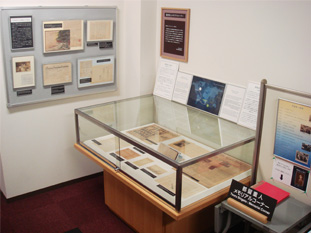


Shigeto Tsuru, who went to the U.S. to study at his father's suggestion in 1931, earned Ph.D. and even served as a lecturer at Harvard University. However he was determined to go back to Japan since he predicted his homeland's loss in the war when the attack on Pearl Harbor happened on December 8th 1941.
This year we display the related materials from the 70th anniversary of the end of World War II exhibition which was very well received last year. It covers from Tsuru went to the U.S. to the outbreak of the war, and to the repatriation by the exchange ship between Japan and America.
Period
July 20-August 31, 2016 (Closed on Saturdays, Sundays and August 11-16)
Hours
9:00am-5:00pm
Location
Shigeto Tsuru Memorial Corner,
Library, Institute of Economic Research, Hitotsubashi University

Outbreak of War in America
In 1930, Shigeto Tsuru, who was arrested for violating the Public Security Preservation Law, was expelled from the 8th school. Following year, he followed his father's suggestion to study abroad and moved to the U.S. He earned Ph.D. and even served as a lecturer at Harvard University, however the attack on Pearl Harbor happened. On December 8th 1941, he had no choice but to go back to Japan by the exchange ship between the U.S. and Japan. Tsuru explained his sentiments at the time as below
After predicting the loss of my home country, I decided to leave the U.S.; it was more regretful for me to part company with many of the colleagues who I had heartfelt friendship with than losing most of the valuable academic resources I had accumulated over the 11 years of my stay in the U.S.
(from Shigeto Tsuru's Autobiography)
Returning to Japan was regretful for Tsuru after going through the enriched research activities and exchanges with many of his friends that gave him excitement. At this exhibition, valuable documents that illustrate international friendship before the war and war memories from Tsuru's unique perspective are displayed.
Japan's loss
After coming back to Japan, his liberal life in Boston took a big turn; he was dragged into Japan's militarism by entering the army and working as the courier for the Ministry of Foreign Affairs. Reflecting on the loss of Japan, he explained as follows;
"50 years from today, young generation who will read this story as historical description might have an impression like this. '...Wasn't it obvious for the Japan's supreme leader at the time to unconditionally surrender to the terms the "Potsdam Declaration" had presented..." These thoughts are totally understandable. However, the military leader could not be flexible with the whole country becoming more militaristic than you could ever imagine from Today's Japan."
(from Shigeto Tsuru's Autobiography)
You can see that even Tsuru, who was critical of Japan becoming militaristic when he was in the U.S., could not speak against, let alone take actions against Japan's militarism during the war. It would be great if this exhibition of Shigeto Tsuru's documents during the war provided you an opportunity to think about "war", especially if you are near the same age as Tsuru during the wartime.
Taiyomaru's Dinner Menu
Tsuru wrote a letter in Romanaized Japanese on the back of the dinner menu and sent it to his parents. September 5th 1931 Hawaii postmark
Explanation of the Varsity Jacket
August 27th 1932 A letter to his parents
Accounting Report to his guardian
September 19th 1936 A letter to his parents
Explaining Washington D.C
During his transfer from Laurence College to Harvard University, Tsuru stopped by Washington D.C. September 9th 1933 A letter to his parents
Harvard University Graduation Certificate 1935
Tsuru graduated the Harvard University's department of Economics with an honors degree "maguna cum laud"
Helping the encounterance between Dr. and Mrs. Samuelson
(Photo of the couple right after their marriage, 1940, and the illustration of the Samuelson Family by Tsuru)
Paul Samuelson was an economist who represented America and was a former classmate of Tsuru at Harvard graduated school . Tsuru introduced Marion to Paul. Marion eventually got married with Paul and they had 6 kids.
Daily Record extra news , December 8th 1941
December 9th 1941. Diary
The diary of the day after the Pearl Harbor attack.
Telegram from the Samuelsons
Tsuru had to go back to Japan in 5 days and he regretted the fault that he couldn't say farewell to the Samuelsons but he received the telegram when he rode the ship.
Postcard for the Samuelsons
The postcard the Tsurus sent to the Samuelsons at the exchange land "Lourenco Marques"
M.S. Gripsholm's Dinner Menu
Repatriation Diary
Tsuru started writing the diary on a pocketbook his friend who worked for the foreign ministry gave him since all of his papers were taken away on the exchange ship. This is the scenary of Rio de Janeiro.
Sketch of the Gripsholm Cabin No.672
The appearance of the cabin of the Tsurus in the Gripsholm Ship from the U.S. to Lourenco Marques. From the "Repatriation Diary"
Repatriation Diary
Tsuru started writing the diary on a pocketbook his friend who worked for the foreign ministry gave him since all of his papers were taken away on the exchange ship. This is the scenary of Rio de Janeiro.
Sketch of the Gripsholm Cabin No.672
The appearance of the cabin of the Tsurus in the Gripsholm Ship from the U.S. to Lourenco Marques. From the "Repatriation Diary"
Sketch of the Polana Beach
Tsuru wrote this sketch at Lourenco Marques, a place where Japan and America's ships met and exchanged passengers. From the "Repatriation Diary"
The Syonan Times , August 9th 1942
Cautionary Note at the Syonan Island
The Japanese army distributed the cautionary note to passengers before leaving the ship.
Timeline (Japanese and English) ( pdf(180 KB) )
Flyer (Japanese) ( pdf(267 KB) )